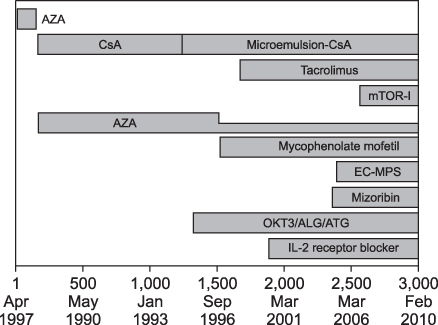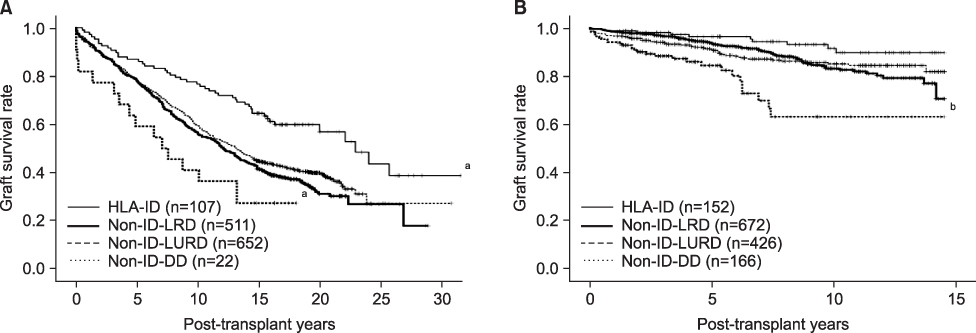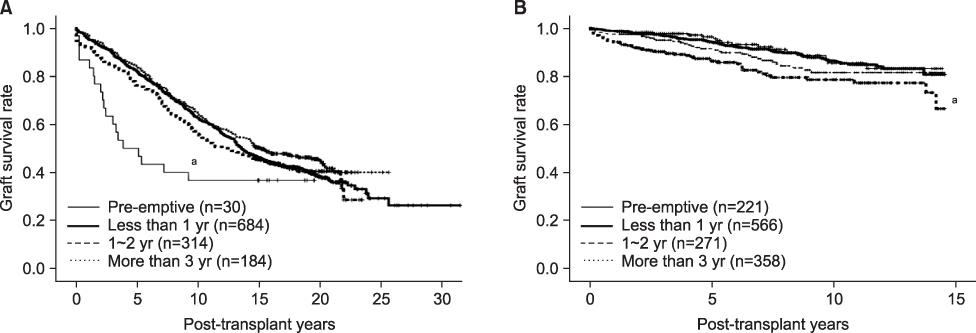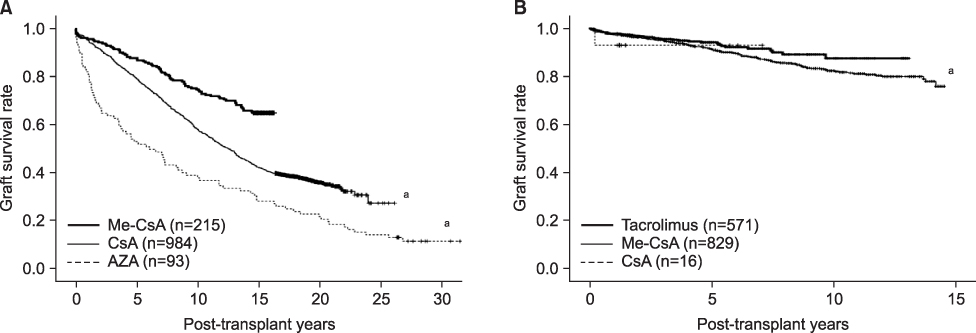Evaluation of Independent Risk Factors Affecting Renal Allograft Survival by Transplant Era
- Affiliations
-
- 1Department of Surgery, Yonsei University College of Medicine, Seoul, Korea. ysms91@yuhs.ac
- 2Research Institute for Transplantation, Yonsei University College of Medicine, Seoul, Korea.
- 3Department of Surgery, Bundang CHA Hospital, CHA University College of Medicine, Seongnam, Korea.
- KMID: 2003533
- DOI: http://doi.org/10.4285/jkstn.2012.26.3.178
Abstract
- BACKGROUND
Using long-term (more than 30 years) data from a single center, this retrospective study evaluated changes of independent risk factors affecting renal allograft survival by transplant era.
METHODS
Of 3,000 cases of kidney transplantation, 2,708 (90.3%), including their follow-up observations, were reviewed. Transplant era was classified according to immunosuppressive regimens as either early group (transplant serial No. 1~1,500) or recent group (transplant serial No. 1,501~3,000).
RESULTS
There was a significant difference observed in pre-transplant clinical manifestations between the early and recent groups. The number of elderly recipients and donors, number of deceased donors, and cases related to pre-transplant diabetes, pre-emptive transplantation, and retransplantation were differed relative to transplant era. The short- and long-term graft survival rate of the recent group improved significantly, and the effect of human leukocyte antigen mismatching and living donor type disappeared in the recent group. Moreover, pre-emptive transplantation and retransplantation were effective only in the recent group. However, non-immunological factors such as elderly recipients and donors, and immunologic factors such as episodes of acute rejection and types of immunosuppressive regimen were persistent independent risk factors affecting graft survival rate.
CONCLUSIONS
According to the retrospective survival analysis of a large number of recipients in a single center, risk factors for kidney transplant patients differed by transplant era. However, the independent risk factors associated with elderly recipients and donors (non-immunologic), and episodes of acute rejection, and types of immunosuppressive regimen (immunologic) persisted regardless of transplant era.
Keyword
MeSH Terms
Figure
Cited by 3 articles
-
Clinical Outcomes and Contributors in Contemporary Kidney Transplantation: Single Center Experience
Jae-Sung Ahn, Kyung Sun Park, Jongha Park, Hyun Chul Chung, Hojong Park, Sang Jun Park, Hong Rae Cho, Jong Soo Lee
J Korean Soc Transplant. 2017;31(4):182-192. doi: 10.4285/jkstn.2017.31.4.182.Alteration of Ankle-Brachial Index after Kidney Transplantation
Dae Jung Kim, Oh Hyun Park, Jeong Seon Jo, Ho Kyun Lee, Sang Young Chung, Soo Jin Na Choi
J Korean Soc Transplant. 2014;28(4):200-203. doi: 10.4285/jkstn.2014.28.4.200.Actual 10-year Outcomes of Tacrolimus/MMF Compared with Cyclosporin/MMF in Kidney Transplantation
Yaerim Kim, Sungbae Park, Hyoungtae Kim, Seungyeup Han
J Korean Soc Transplant. 2014;28(2):69-77. doi: 10.4285/jkstn.2014.28.2.69.
Reference
-
1. Kwon SW, Oh CK, Kim YS, Cho HR, Kim YS, Park KI. Multivariate and univariate analyses of risk factors affecting graft survival of 700 primary living donor renal transplants based on Yonsei Medical Center experience. J Korean Surg Soc. 1993. 44:728–739.2. Kim BS, Kim SC, Kim TH, Han DJ. Clinical analysis of efficacy and safety for FK506 after renal transplantation. J Korean Soc Transplant. 2002. 16:76–83.3. Kim SC, Han DJ, Kim TH, Kim SC. Mycophenolate mofetil versus azathioprine in cyclosporine based triple immunosuppression. J Korean Soc Transplant. 2002. 16:70–75.4. Shapiro R, Young JB, Milford EL, Trotter JF, Bustami RT, Leichtman AB. Immunosuppression: evolution in practice and trends, 1993-2003. Am J Transplant. 2005. 5(4 Pt 2):874–886.
Article5. Initial maintenance immunosuppressive medications. Am J Transplan. 2009. 9:Suppl 3. S10–S13.6. Kaneku HK, Terasaki PI. Thirty year trend in kidney transplants: UCLA and UNOS Renal Transplant Registry. Clin Transpl. 2006. 1–27.7. Opelz G. Impact of HLA compatibility on survival of kidney transplants from unrelated live donors. Transplantation. 1997. 64:1473–1475.
Article8. Ahmad N, Ahmed K, Khan MS, Calder F, Mamode N, Taylor J, et al. Living-unrelated donor renal transplantation: an alternative to living-related donor transplantation? Ann R Coll Surg Engl. 2008. 90:247–250.
Article9. Lee SH, Huh KH, Kim SJ, Joo DJ, Ju MK, Kim MS, et al. Clinical outcomes of spousal donor kidney transplantation: single center experience. J Korean Soc Transplant. 2008. 22:232–237.10. Moon JI, Lee CM, Kim SI, Kim MS, Kim YS, Park K. The impact of acute rejection on long-term graft outcome in renal allograft recipient. J Korean Soc Transplant. 1998. 12:67–74.11. Sellarés J, de Freitas DG, Mengel M, Reeve J, Einecke G, Sis B, et al. Understanding the causes of kidney transplant failure: the dominant role of antibody-mediated rejection and nonadherence. Am J Transplant. 2012. 12:388–399.
Article12. Kim YS, Kim MS, Kim SI, Chung CW, Lee HY, Han DS, et al. Analysis of risk factors affecting the primary living donor renal allograft survival: a single center study based on 1,043 transplants. Korean J Nephrol. 1996. 15:184–193.13. Jeon KO, Kim MS, Kim YS, Nam JM, Huh KH, Kim SI, et al. Analysis of risk factors affecting the graft survival in living unrelated donor kidney transplantation. J Korean Soc Transplant. 2004. 18:155–163.14. Fabrizii V, Kovarik J, Bodingbauer M, Kramar R, Hörl WH, Winkelmayer WC. Long-term patient and graft survival in the eurotransplant senior program: a single-center experience. Transplantation. 2005. 80:582–589.
Article15. Kim MS, Kim DK, Myoung SM, Kim SI, Oh CK, Kim YS, et al. Chronologically different impacts of immunologic and non-immunologic risk factors on renal allograft function. Clin Transplant. 2005. 19:742–750.
Article16. Levine MH, Reese PP, Wood A, Baluarte JH, Huverserian A, Naji A, et al. Inferior allograft outcomes in adolescent recipients of renal transplants from ideal deceased donors. Ann Surg. 2012. 255:556–564.
Article17. Delucchi A, Gutierrez H, Arrellano P, Slater C, Meneses M, López I. Factors that influence nonadherence in immunosuppressant treatment in pediatric transplant recipients: a proposal for an educational strategy. Transplant Proc. 2008. 40:3241–3243.
Article18. LaRosa C, Baluarte HJ, Meyers KE. Outcomes in pediatric solid-organ transplantation. Pediatr Transplant. 2011. 15:128–141.
Article19. Ahn HJ, Kim YS, Kim SI, Lee JH, Ju MK, Kim MS, et al. Risk factors affecting long-term outcome in kidney re-transplantation recipients. J Korean Soc Transplant. 2006. 20:73–78.20. Ahn HJ, Kim MS, Kim YS, Kim SI, Huh KH, Ju MK, et al. Clinical outcome of renal transplantation in patients with positive pre-transplant hepatitis B surface antigen. J Med Virol. 2007. 79:1655–1663.
Article21. Lee SW, Kang SW, Choi KH, Han KH, Lee HY, Han DS, et al. The clinical outcome of anti - HCV (+) renal allograft recipients. J Korean Soc Transplant. 1995. 9:115–117.
- Full Text Links
- Actions
-
Cited
- CITED
-
- Close
- Share
- Similar articles
-
- Post-Renal Transplantation Dyslipidemia
- The Outcome and Risk Factors of Renal Retransplantation
- The Effect of Hypercholesterolemia and Hypertension on Long-term Renal Allograft Survival
- Effects of Perioperative Blood Transfusion on Renal Allograft Rejection and Graft Survival
- Diagnosis of renal transplant rejection: Banff classification and beyond






